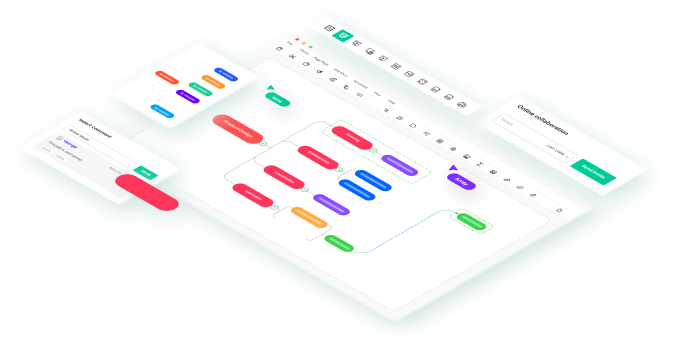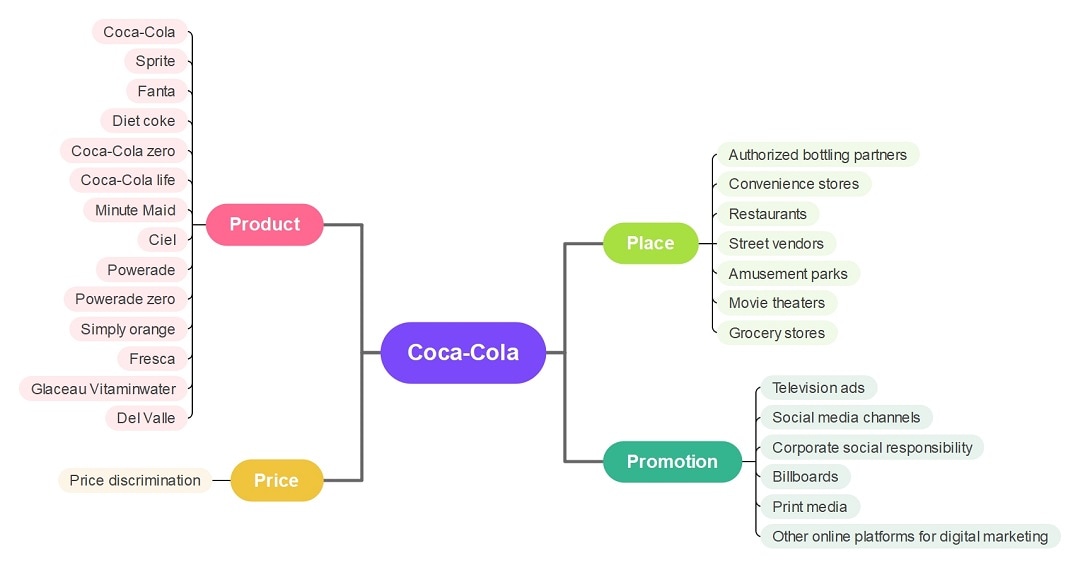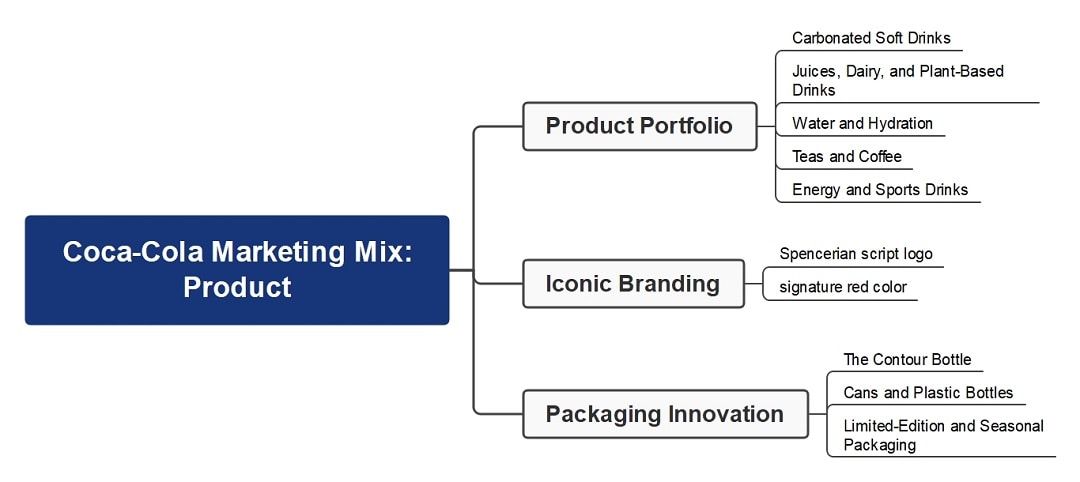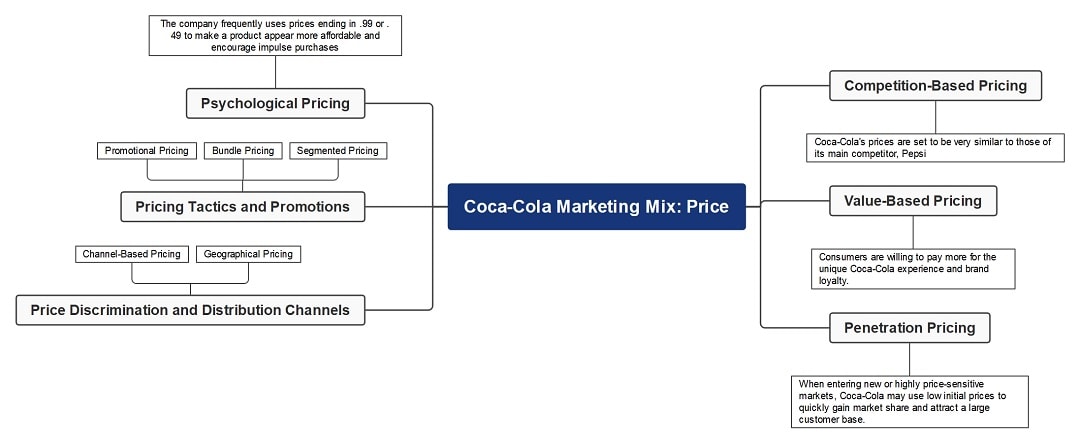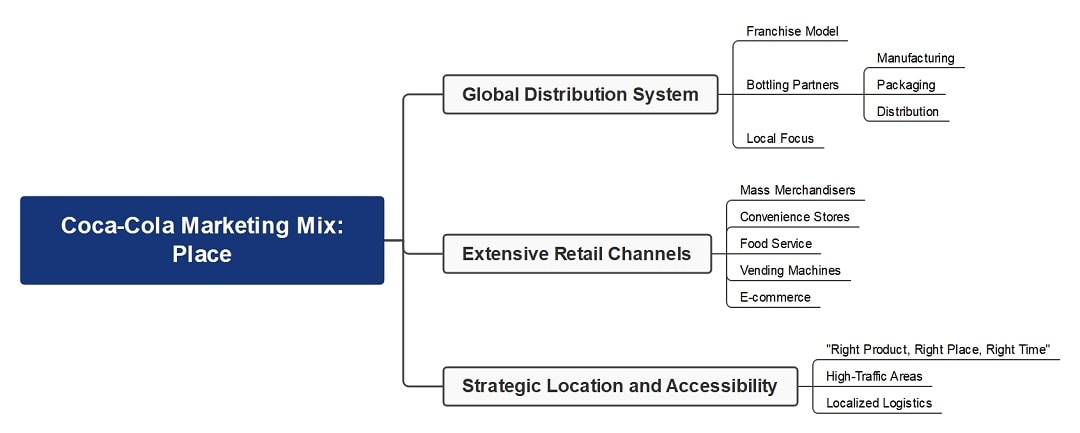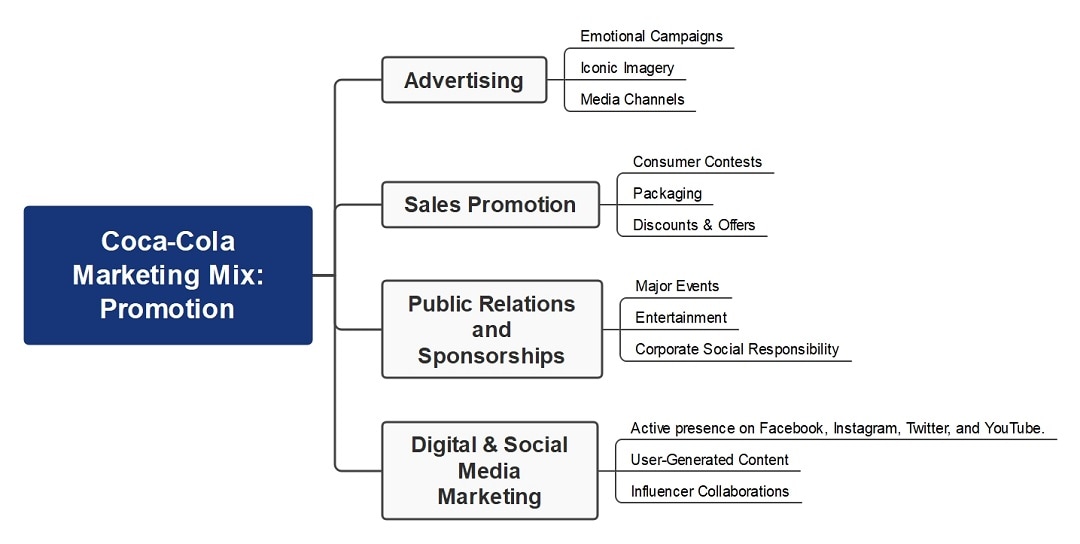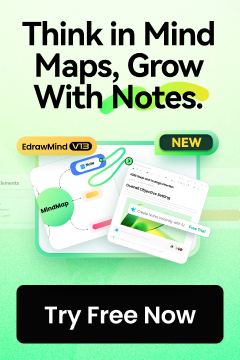Coca-Cola’s 4Ps marketing mix analysis is a fantastic way to learn how this global brand dominates the world. Its product, price, place, and promotion marketing strategies display the ways in which the company tends to millions of people each day.
Here, you will understand how Coca-Cola creates its product, sets its prices, touches base with its customers, and promotes itself as a brand.
You will also get to see some examples and types of strategies that make it relevant to this day in many markets. Read further to see how these 4Ps combine to make Coca-Cola the beloved company.
In this article
- Overview of the Coca-Cola Company
- Mind Map for the 4Ps of Marketing of Coca-Cola
- Coca-Cola Marketing Mix: Product
- Coca-Cola Marketing Mix: Price
- Coca-Cola Marketing Mix: Place
- Coca-Cola Marketing Mix: Promotion
- How To Make a 4Ps Marketing Mix Mind Map for Coca-Cola
- Tips To Make a 4Ps Marketing Mix Mind Map
Overview of the Coca-Cola Company
The Coca-Cola company is a bigger deal than you might think. In 2024, they raked in $47.1 billion in net revenue and a 12% organic revenue growth. Their operating income increased 22% for the full year.
They pushed around 33.7 billion unit cases worldwide, with sparkling drinks making up 69% of that volume. And good Trademark Coca-Cola holding 47% of all global cases.
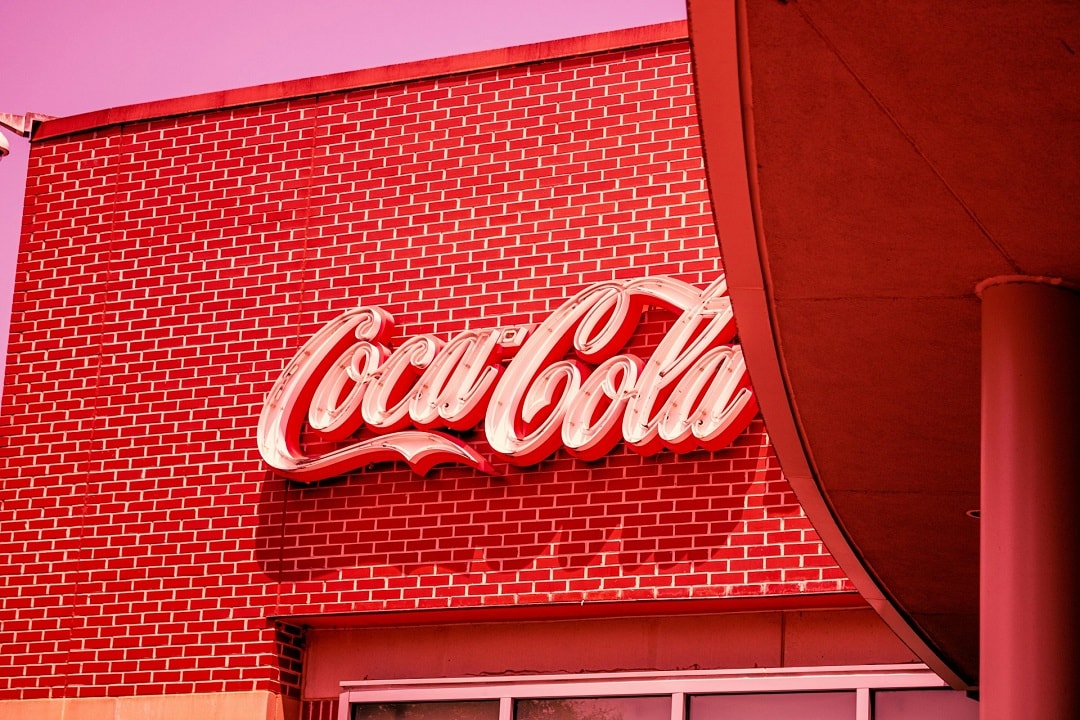
Born in Atlanta back in 1892, this company has morphed from a single syrup into a beverage leader. Reaching a global audience, Coca-Cola provides over 2.2 billion servings daily to more than 200 countries and territories. Coca-Cola isn’t only a soda brand. It’s a global beverage powerhouse with numbers to flex. Check this out:
| Aspect | Details |
| Founded | 1892 (Atlanta, Georgia) by Asa Griggs Candler |
| Daily Reach | 2.2 billion drink servings in over 200 countries |
| 2024 Revenue | $47.1 billion |
| Product Mix | Carbonated soft drinks, juices, water, tea, coffee, and plant-based options |
| Official Source | Visit coca-colacompany.com for real-time investor updates and breakdowns |
Mind Map for the 4Ps of Marketing of Coca-Cola
A marketing mix can help you understand how a company implements its strategy. This pictorial representation allows you to present the four cornerstones of strategy: product, price, place, and promotion.
Taking Coca-Cola as an example, this method reveals how the brand's decision is interconnected. It indicates how one of the world's most famous names maintains its essence while remaining adaptable to different local tastes and markets.
Coca-Cola Marketing Mix: Product
Coca-Cola's product strategy has long begun with its iconic beverage. That red can remains the company's core, but Coca-Cola is much more than one formula these days. Now, Coca-Cola operates more than 200 brands and thousands of products. The scope is enormous: sparkling sodas, bottled water, juices, teas, coffees, and even energy drinks. And with so many offerings, there is a Coca-Cola product to suit nearly every kind of consumer. New tastes keep the brand fresh. Flavors such as Cherry, Vanilla, or Zero Sugar are no longer afterthoughts. They are the main members of the family. Limited releases also keep consumers intrigued. A limited-time release or an unexpected flavor creates buzz and brings attention back to the stores. These actions keep Coca-Cola relevant in an oversaturated market.
The company also adapts products to suit local tastes. In India, Thums Up is the cola of choice because people prefer a stronger flavor. In Japan, Coca-Cola has released cherry blossom editions and even launched adult-oriented drinks such as Lemon-dou. Local strategies like these make the global brand feel personal.
The range of healthy options is likewise expanding. For instance, the no-sugar Coca-Cola has become the best-selling product worldwide. You can also see the launch of functional drinks with added vitamins or prebiotics. This targets young people who are into health and well-being. The point is clear: Coca-Cola recognizes that consumers want different products, and therefore creates products that cater to various consumer types.
Coca-Cola Marketing Mix: Price
The Coca-Cola company applies a combination of pricing strategies that are in line with both its brand value and customer habits.
One of the pricing strategies Coca-Cola uses is value-based pricing. People don’t simply buy a Coke for the liquid inside. They receive the experience, the familiar taste, and the bond with a brand that gives them a sense of being close to the whole world. This feeling of value is what keeps Coca-Cola from losing its place among more affordable alternatives.
Psychological pricing plays a role, too. You’ll often see Coca-Cola products priced ending at odd numbers, for instance, at $7.99 instead of $8. That small difference makes it seem more affordable. It’s a simple strategy but effective, especially in convenience stores and vending machines where impulse buys matter.
Then there’s competitor-based pricing. Pepsi is the obvious rival, and Coca-Cola often adjusts to stay competitive while reminding buyers that it offers more than just a soda.
The competition keeps prices in check without watering down the brand’s value. Packaging is an important factor in the pricing. Products in smaller bottles and cans are priced to attract customers who are on a budget or those who want convenience.
The price of products in large bottles and multipacks is intended for families and group settings. Bundling is often accompanied by discounts, which are an incentive for customers to purchase in larger quantities. There are also the so-called "premium releases" - limited editions or special packaging - that are sold at a higher price because of their exclusivity.
Coca-Cola Marketing Mix: Place
Distribution is the point where Coca-Cola has a competitive advantage over other companies. The company's beverages are available at more than 200 locations worldwide. Only a few brands can match such a reach. The reason for this is that Coca-Cola collaborates with local bottlers who take care of the production and distribution in their respective areas.
The system maintains a smooth process while ensuring that products meet standards everywhere. You can find Coca-Cola products in every retail channel imaginable. It is available in small corner stores. Supermarkets give whole aisles to it. Restaurants, fast-food chains, and hotels have it as a default option on their menu.
Vending machines are there to keep the bottles cool at train stations, schools, and malls. The strategy is straightforward: no matter where you are, Coca-Cola wants to be there right next to you. The company also focuses on logistics. It invests in refrigeration systems to keep drinks cold and employs shelf placement for visibility.
Coca-Cola even tailors its distribution to local habits. In countries favoring convenience stores, the focus is on single-serve bottles and cans. In areas where families buy in bulk, multipacks are more common. E-commerce has become another channel. Ordering drinks online for delivery is now part of Coca-Cola’s global system. This shows how flexible the company is. Whether you buy in person or online, Coca-Cola makes sure the product is never far from reach.
Coca-Cola Marketing Mix: Promotion
Promotion has always been the sphere where Coca-Cola has left its most elaborate legacy. Its campaign is more than just an advertisement; it is an element of pop culture. Besides, from the “Hilltop” commercial in the 1970s to the “Share a Coke” campaign, Coca-Cola has become a pro at evoking emotions. You can consider the idea behind "Share a Coke" as one of its most powerful ones. In a very simple way, the company had every person's name printed on a bottle. This helps the purchase of an ordinary product become a personal experience.
Thus, people were not only buying soda but were searching for their names or picking bottles for friends and family. In this way, the company increased not only the love for the brand but also sales simultaneously.
Another standout campaign is “Taste the Feeling.” It focused on the role Coca-Cola plays in everyday moments, big or small. Instead of pushing features, the ads showed feelings like joy, togetherness, and refreshment. This approach made the brand feel human and universal. Aside from that, sponsorships are another major aspect of promotion strategy.
The fact that Coca-Cola sponsors such sporting events as the Olympic Games, FIFA World Cup, and different concerts gives the company access to the celebrations that occur all over the world. Coca-Cola is present at these spectacles that millions of people watch. And it does so in a way that ensures its logo is always visible.
The company has also taken advantage of online channels. Young people have also been the target of digital campaigns, social networks, influencers, and interactive promotions. Limited flavors with celebrity partnerships or gaming tie-ins are popular online. That is, with followers quickly spreading the word and wanting to buy the flavors in the retail store.
Coca-Cola promotions were definitely successful and entertaining, but there's more to it. The brand has produced content on the environment, created community-based programs, and organized recycling campaigns. These initiatives have greatly influenced the views of the brand among the consumers, as they associate it with not only fun but great social responsibility as well.
How To Make a 4Ps Marketing Mix Mind Map for Coca-Cola
The 4Ps of marketing for Coca-Cola spans a whole lot of ground, and keeping track of all those nitty-gritties can be frustrating. One mind map can help you, whether you are studying, planning, or sharing ideas with others.
Use a Professional 4Ps Marketing Mix Mind Map Maker
Wondershare EdrawMind is a collaborative mind mapping tool that you can download and try for free. Visualizing Coca-Cola’s 4Ps through a mind map will make your presentation more appealing. For marketers, it’s a step to become more interactive. You can actually apply the same methodology to your brand or product strategy. Also, teams can benefit, as a mind map simplifies the point of view for everyone without the need for a time-consuming discussion.
Even if you were mapping out a small project, you would have saved a lot of time with the templates and drag-and-drop features. EdrawMind has its users on the same page, providing you with different layouts, themes, and AI tools to help you brainstorm, plan, and collaborate.
Steps To Make a Marketing Mix Mind Map
Here's how to create a marketing mix mind map for Coca-Cola:
Step 1: Create a Mind Map
Click Create from the top left corner of the dashboard, then click Blank Mind Map.
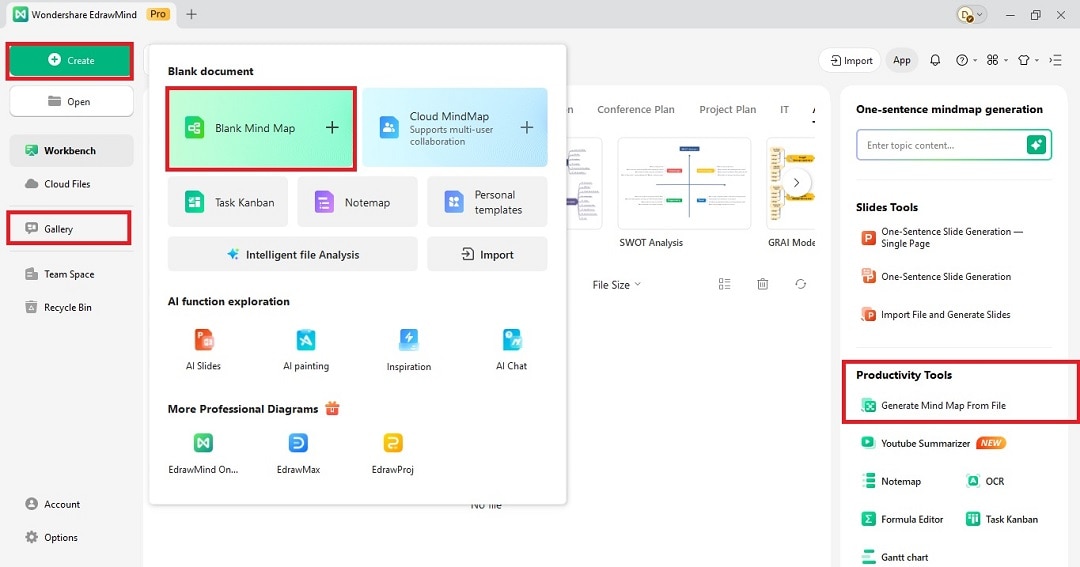
Another option is to use a template from the Gallery menu on the left side navigation. Alternatively, select the Generate Mind Map from File option below the Productivity Tools section.
Step 2: Add Main Branches
Set your central topic to "Coca-Cola Marketing Mix." From this, create four main branches labeled with the 4Ps: Product, Price, Place, and Promotion. Tip: You can change the style of the blank mind map. To do so, open the right panel and choose an option from the Layout section.
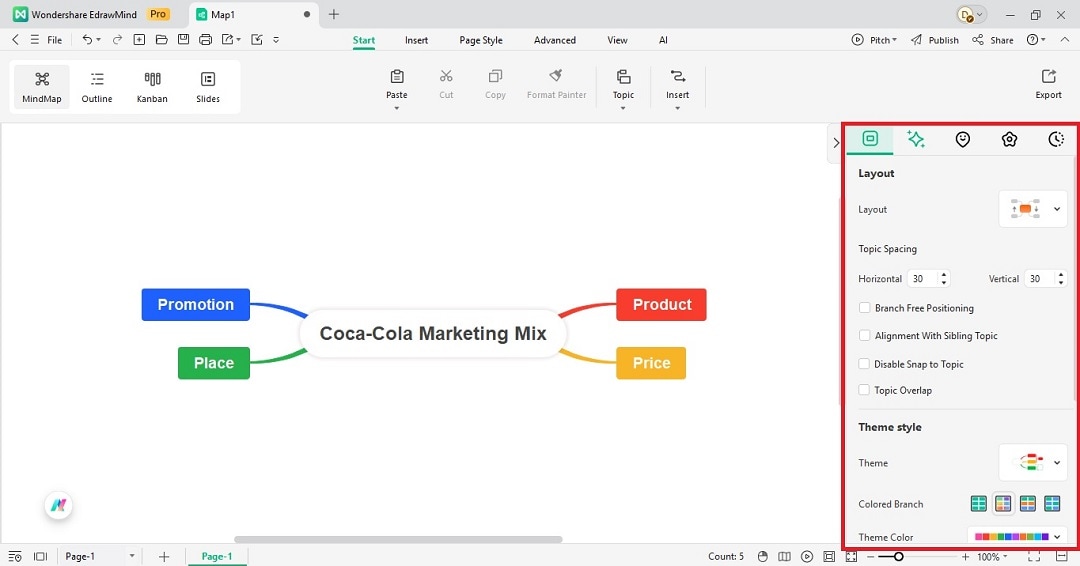
Step 3: Add Key Details
Add sub-branches to each of the 4 Ps with specific examples for Coca-Cola. Select a main branch, then click More on the floating toolbar and choose Subtopic.
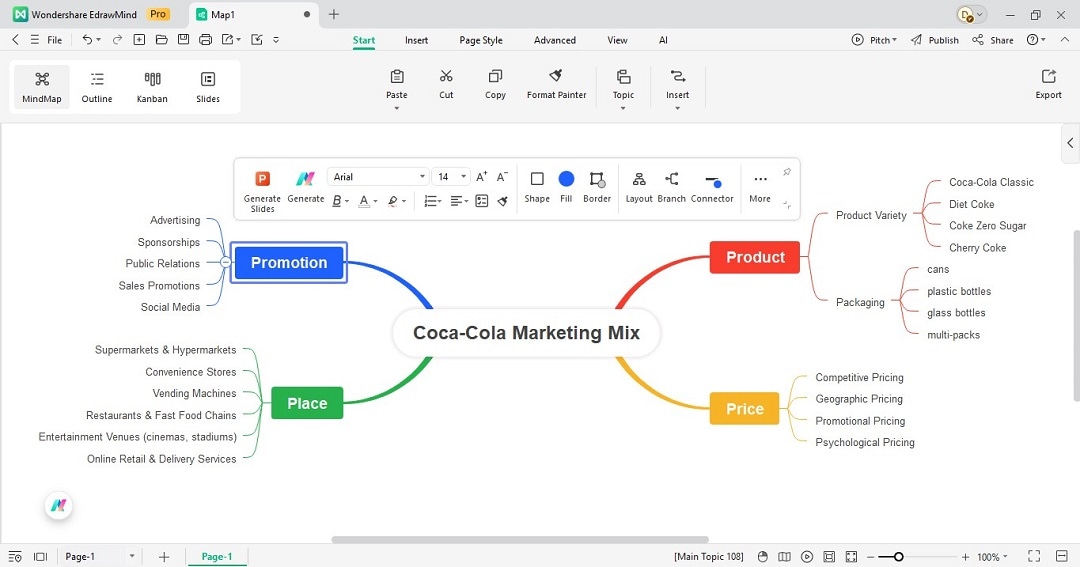
Step 4: Customize and Export
Go to Theme style on the right panel to change the theme in one click. Once you've reviewed the content, export the mind map.
Tips To Make a 4Ps Marketing Mix Mind Map
The 4Ps marketing mix mind map is most effective when it is simple, straightforward, and expandable. The main objective is to have your concepts arranged such that you can recognize the trends easily. Go from general to specific. For each core branch, list broad ideas and then add sub-branches with the details. Present cases.
Within each branch, jot down actual products, advertisements, or prices to visualize the map. Emphasize the most important points. For the key ideas, consider using bold, larger fonts, or more eye-catching colors.
Include time frames. Mark dates for promotions or product launches so the map can serve as a scheduling tool. Remain open to changes. Create a space for fresh ideas or shifts in the market. Update the mind map along with your strategy. Connect the dots. Use linking lines when two things share a commonality, such as promotions related to product bundles.
FAQ
-
Why Is Coca-Cola So Successful in Marketing?
Emotions are what the Coca-Cola company sells. The brand depicts Coke as a product of happiness, sharing, and the time spent with friends. Ads focus on how it feels, not only taste or price. A combination of visuals, slogans, and global yet locally relevant stories makes the brand recognizable. This is what makes the customers feel related to the brand. -
What Is the Coca-Cola Packaging Strategy?
Coca-Cola's emphasis is on creating a circular system, whereby the containers and cans will not become waste. The company is making all its packaging recyclable. Also, it is striving to elevate the proportion of recycled materials used. Gathering and recycling more of the packaging that is released into the market is also an important feature of the program. -
What Is the Target Audience of Coca-Cola?
The target market of Coca-Cola is aged between 10 and 25 years, and young adults aged 26 to 40 years. The brand mixes strategies. Mass messages build reach. Targeted campaigns cater to niches by need or lifestyle. In some cases, focused efforts win specific segments, such as fitness seekers or value shoppers.



